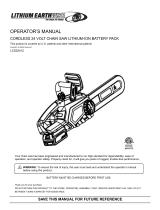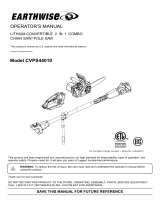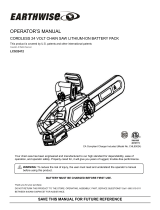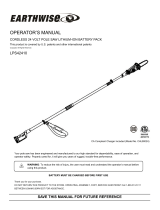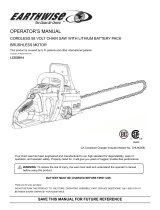
3
GENERAL POWER TOOL SAFETY WARNINGS
Use the power tool, accessories and tool bits etc. in
accordance with these instructions, taking into
account the working conditions and the work to be
performed. Use of the power tool for operations different
from those intended could result in a hazardous situation.
Service
Have your power tool serviced by a qualified repair
person using only identical replacement parts. This
will ensure that the safety of the power tool is maintained.
When servicing a power tool, use only identical
replacement parts. Follow instructions in the
Maintenance section of this manual. Use of
unauthorized parts or failure to follow Maintenance
instructions may create a risk of shock or injury.
CHAIN SAW SAFETY WARNINGS
Keep all parts of the body away from the saw chain
when the chain saw is operating. Before you start the
chain saw, make sure the saw chain is not contacting
anything. A moment of inattention while operating chain
saws may cause entanglement of your clothing or body
with the saw chain.
Always hold the chain saw with your right hand on the
rear handle and your left hand on the front handle.
Holding the chain saw with a reversed hand configuration
increases the risk of personal injury and should never be
done.
Hold the power tool by insulated gripping surfaces
only, because the saw chain may contact hidden
wiring or its own cord. Saw chains contacting a live wire
may make exposed metal parts of the power tool live and
could give the operator an electric shock.
Wear safety glasses and hearing protection. Further
protective equipment for head, hands, legs and feet is
recommended. Adequate protective clothing will reduce
personal injury by flying debris or accidental contact with
the saw chain.
Do not operate a chain saw in a tree. Operation of a
chain saw while up in a tree may result in personal injury.
Always keep proper footing and operate the chain saw
only when standing on fixed, secure and level surface.
Slippery or unstable surfaces such as ladders may cause a
loss of balance or control of the chain saw.
When cutting a limb that is under tension be alert for
spring back. When the tension in the wood fibres is
released the spring loaded limb may strike the operator
and/or throw the chain saw out of control.
Use extreme caution when cutting brush and saplings.
The slender material may catch the saw chain and be
whipped toward you or pull you off balance.
Carry the chain saw by the front handle with the chain
saw switched off and away from your body. When
transporting or storing the chain saw always fit the
guide bar cover. Proper handling of the chain saw will
reduce the likelihood of accidental contact with the moving
saw chain.
Follow instructions for lubricating, chain tensioning
and changing accessories. Improperly tensioned or
lubricated chain may either break or increase the chance
for kickback.
Keep handles dry, clean, and free from oil and grease.
Greasy, oily handles are slippery causing loss of control.
Cut wood only. Do not use chain saw for purposes
not intended. For example: do not use chain saw for
cutting plastic, masonry or non-wood building
materials. Use of the chain saw for operations different
than intended could result in a hazardous situation.
Causes and operator prevention of kickback:
Kickback may occur when the nose or tip of the guide bar
touches an object, or when the wood closes in and
pinches the saw chain in the cut.
Tip contact in some cases may cause a sudden reverse
reaction, kicking the guide bar up and back towards the
operator.
Pinching the saw chain along the top of the guide bar
may push the guide bar rapidly back towards the
operator.
Either of these reactions may cause you to lose control of
the saw which could result in serious personal injury. Do
not rely exclusively upon the safety devices built into your
saw. As a chain saw user, you should take several steps
to keep your cutting jobs free from accident or injury.
Kickback is the result of tool misuse and/or incorrect
operating procedures or conditions and can be avoided
by taking proper precautions as given below:
Maintain a firm grip, with thumbs and fingers
encircling the chain saw handles, with both hands on
the saw and position your body and arm to allow you
to resist kickback forces. Kickback forces can be
controlled by the operator, if proper precautions are
taken. Do not let go of the chain saw.
Do not overreach and do not cut above shoulder
height. This helps prevent unintended tip contact and
enables better control of the chain saw in unexpected
situations.
Only use replacement bars and chains specified by
the manufacturer. Incorrect replacement bars and
chains may cause chain breakage and/or kickback.
Follow the manufacturer’s sharpening and
maintenance instructions for the saw chain.
Decreasing the depth gauge height can lead to increased
kickback.















